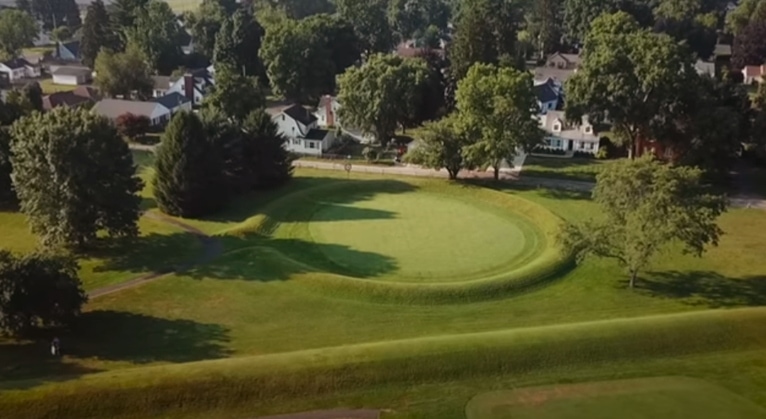Drone Imagery Could Help Turn Ancient Native American Earthworks into a UNESCO World Heritage Site
BY Zacc Dukowitz
21 April 2021Drone imagery may provide crucial evidence in a case historians are making to preserve the ancient Octagon Earthworks in Newark, OH by making it a UNESCO World Heritage Site.
The earthworks were built by Native Americans over 2,000 years ago as a way to measure the movements of the sun and moon.
They are currently located on a golf course at the Moundbuilders Country Club. The club has leased the land for over 100 years, and preserving the mounds is a priority to its owners and to club members—but people are still permitted to walk on them if they need to make a shot.

Shot taken from reporting done by The Columbus Dispatch
One of the most striking earthworks on the course is a circular mound that wraps around the third hole (shown above).
The mound makes for a challenging play, since it requires golfers to take a blind shot over it. But historians and archaeologists are pushing to have the golf course relocated so that the earthworks can be better preserved and appreciated.
Both club owners and members are generally sympathetic to this push. But the sticking point is how much the country club should get for relocating.
The club has a lease on the land until 2078, but the state of Ohio is trying to buy them out under eminent domain. The state has offered $1.7 million—up from an initial offer of $800,000—but club owners say they’ll need $12 million to create a new course.
The Push to Make the Octagon Earthworks a UNESCO Site
The Octagon Earthworks is the largest set of geometric earthen enclosures in the world.
That may not have been the case a century ago, when hundreds of similar earthworks existed throughout North America. The Octagon site is just a part of the Newark Earthworks, which originally spanned 4.5 square miles and included 7 million cubic feet of earth.
But over time, many of these earthworks and others throughout the state have been destroyed due to a lack of awareness about their importance.
The mounds were created by the Hopewell culture, and they serve a purpose beyond their interesting appearance.
In an arrangement similar to that found at Stonehenge, an observer standing on the “observatory mound” can see the moon hover exactly over the octagon’s center. This happens once every 18.6 years, as part of a long cycle of the moon’s orbit.


Drone shot of a man standing on observatory mound (Image credit: The Columbus Dispatch)
This an incredibly impressive accomplishment, especially given that the mounds were built around 2,000 years ago.
One reason for the staying power of the mounds is that the Hopewell people were master’s of soil science, according to archaeologist Brad Lepper. In building their earthworks, the Hopewell only chose earth that would stay in place for generations, intentionally creating something that would last.
[Related read: Drone Helps Archaeologists Discover Tomb Containing 72 Ancient Skeletons in Canary Islands]
Given all of this history and the dwindling presence of these earthworks in the state due to a lack of proper preservation, the U.S. Department of the Interior selected the Octagon Earthworks for nomination as a UNESCO World Heritage site back in 2018.
The selection included other mounds throughout the state of Ohio as well, known collectively as the Hopewell Ceremonial Earthworks.
World Heritage Sites are unique places of natural, historic and cultural importance that are treasured by people of all nations. The remarkable legacy of the Hopewell culture’s people in Ohio connects us to those who inhabited our land thousands of years ago. The World Heritage Convention offers us a way for the world to recognize their value.
– Ryan Zinke, U.S. Secretary of the Interior
But a UNESCO designation is unlikely for the Octagon Earthworks site until it can be made open to the public. Currently, the club only opens the site four times a year, as well as allowing visitors on Mondays (visitors can also view them at any time from a platform located in the parking lot).
Drone Imagery Showcases Brilliance of Octagon Earthworks
A striking aspect of the Octagon Earthworks is that they don’t look nearly as impressive from the ground as they do from the sky.


What makes this even more noteworthy is that the Hopewell people were working only from the ground when they built these earthworks. They didn’t have a way to go into the air and double check that their creations, which were built slowly with baskets of earth and clamshell hoes, were coming along as expected.
[Learn how archaeologists are using drones equipped with LiDAR to discover hidden ruins]
Some academics speculate that this aerial aspect served a religious function, and that the Hopewell people wanted them to be seen by their moon and sun gods.
The [mound] effort might have been an attempt to connect with or communicate with the powers which appeared to control the larger universe.
– Ray Hively, Professor Emeritus of Astronomy and Physics at Earlham College
And now, with drones, we can more fully appreciate the brilliance of what the Hopewell people made. Drone imagery helps us see the Octagon Earthworks in all their glory, showcasing the engineering know-how and the sheer creativity of perspective required for their creation.
Know of other archaeological sites that have been discovered or beautifully showcased using drone technology? Share what you know in this thread on the UAV Coach community forum.


